Leadership and Management in SMEs
VerifiedAdded on 2020/02/05
|10
|3718
|46
Literature Review
AI Summary
This assignment examines the crucial roles of leadership, entrepreneurship, and management within Small and Medium-Sized Enterprises (SMEs). It analyzes various leadership styles and their effects on business operations, both positive and negative. The document highlights the benefits SMEs gain from these elements, such as enhanced competitiveness and resource utilization. Ultimately, it emphasizes how these factors contribute to economic growth and success in the SME sector.
Contribute Materials
Your contribution can guide someone’s learning journey. Share your
documents today.

Developing Research
Informed Learning
and Practices
Informed Learning
and Practices
Secure Best Marks with AI Grader
Need help grading? Try our AI Grader for instant feedback on your assignments.
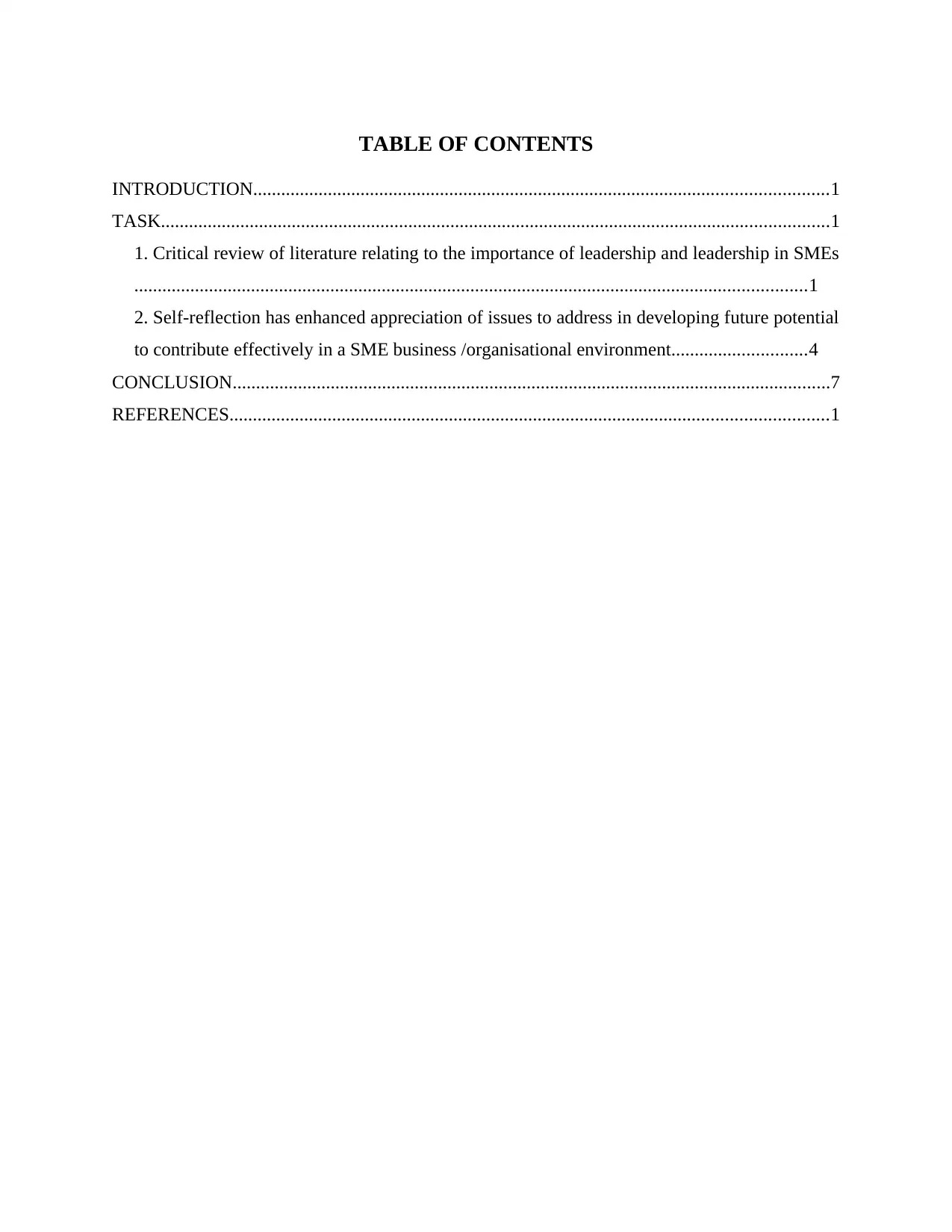
TABLE OF CONTENTS
INTRODUCTION...........................................................................................................................1
TASK...............................................................................................................................................1
1. Critical review of literature relating to the importance of leadership and leadership in SMEs
................................................................................................................................................1
2. Self-reflection has enhanced appreciation of issues to address in developing future potential
to contribute effectively in a SME business /organisational environment.............................4
CONCLUSION................................................................................................................................7
REFERENCES................................................................................................................................1
INTRODUCTION...........................................................................................................................1
TASK...............................................................................................................................................1
1. Critical review of literature relating to the importance of leadership and leadership in SMEs
................................................................................................................................................1
2. Self-reflection has enhanced appreciation of issues to address in developing future potential
to contribute effectively in a SME business /organisational environment.............................4
CONCLUSION................................................................................................................................7
REFERENCES................................................................................................................................1
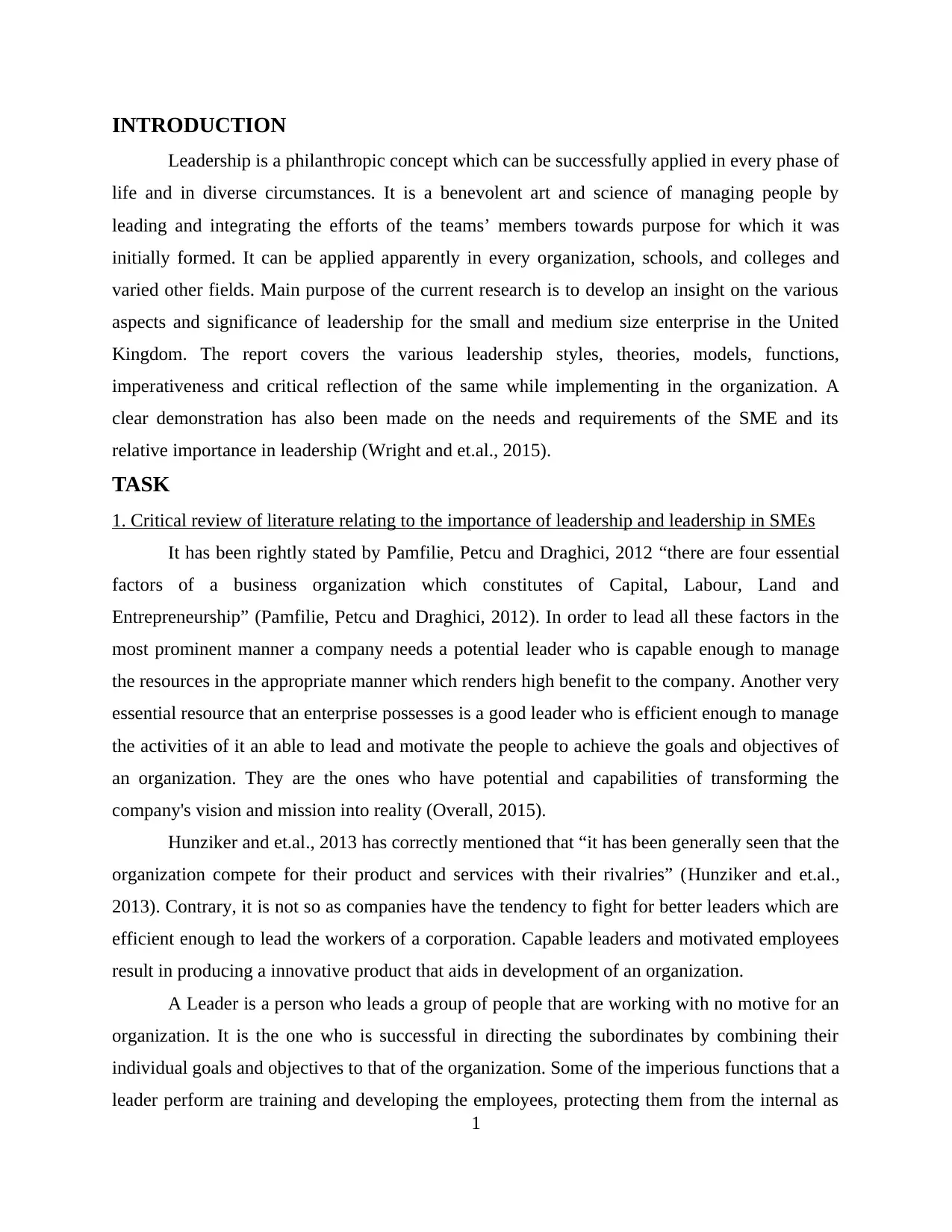
INTRODUCTION
Leadership is a philanthropic concept which can be successfully applied in every phase of
life and in diverse circumstances. It is a benevolent art and science of managing people by
leading and integrating the efforts of the teams’ members towards purpose for which it was
initially formed. It can be applied apparently in every organization, schools, and colleges and
varied other fields. Main purpose of the current research is to develop an insight on the various
aspects and significance of leadership for the small and medium size enterprise in the United
Kingdom. The report covers the various leadership styles, theories, models, functions,
imperativeness and critical reflection of the same while implementing in the organization. A
clear demonstration has also been made on the needs and requirements of the SME and its
relative importance in leadership (Wright and et.al., 2015).
TASK
1. Critical review of literature relating to the importance of leadership and leadership in SMEs
It has been rightly stated by Pamfilie, Petcu and Draghici, 2012 “there are four essential
factors of a business organization which constitutes of Capital, Labour, Land and
Entrepreneurship” (Pamfilie, Petcu and Draghici, 2012). In order to lead all these factors in the
most prominent manner a company needs a potential leader who is capable enough to manage
the resources in the appropriate manner which renders high benefit to the company. Another very
essential resource that an enterprise possesses is a good leader who is efficient enough to manage
the activities of it an able to lead and motivate the people to achieve the goals and objectives of
an organization. They are the ones who have potential and capabilities of transforming the
company's vision and mission into reality (Overall, 2015).
Hunziker and et.al., 2013 has correctly mentioned that “it has been generally seen that the
organization compete for their product and services with their rivalries” (Hunziker and et.al.,
2013). Contrary, it is not so as companies have the tendency to fight for better leaders which are
efficient enough to lead the workers of a corporation. Capable leaders and motivated employees
result in producing a innovative product that aids in development of an organization.
A Leader is a person who leads a group of people that are working with no motive for an
organization. It is the one who is successful in directing the subordinates by combining their
individual goals and objectives to that of the organization. Some of the imperious functions that a
leader perform are training and developing the employees, protecting them from the internal as
1
Leadership is a philanthropic concept which can be successfully applied in every phase of
life and in diverse circumstances. It is a benevolent art and science of managing people by
leading and integrating the efforts of the teams’ members towards purpose for which it was
initially formed. It can be applied apparently in every organization, schools, and colleges and
varied other fields. Main purpose of the current research is to develop an insight on the various
aspects and significance of leadership for the small and medium size enterprise in the United
Kingdom. The report covers the various leadership styles, theories, models, functions,
imperativeness and critical reflection of the same while implementing in the organization. A
clear demonstration has also been made on the needs and requirements of the SME and its
relative importance in leadership (Wright and et.al., 2015).
TASK
1. Critical review of literature relating to the importance of leadership and leadership in SMEs
It has been rightly stated by Pamfilie, Petcu and Draghici, 2012 “there are four essential
factors of a business organization which constitutes of Capital, Labour, Land and
Entrepreneurship” (Pamfilie, Petcu and Draghici, 2012). In order to lead all these factors in the
most prominent manner a company needs a potential leader who is capable enough to manage
the resources in the appropriate manner which renders high benefit to the company. Another very
essential resource that an enterprise possesses is a good leader who is efficient enough to manage
the activities of it an able to lead and motivate the people to achieve the goals and objectives of
an organization. They are the ones who have potential and capabilities of transforming the
company's vision and mission into reality (Overall, 2015).
Hunziker and et.al., 2013 has correctly mentioned that “it has been generally seen that the
organization compete for their product and services with their rivalries” (Hunziker and et.al.,
2013). Contrary, it is not so as companies have the tendency to fight for better leaders which are
efficient enough to lead the workers of a corporation. Capable leaders and motivated employees
result in producing a innovative product that aids in development of an organization.
A Leader is a person who leads a group of people that are working with no motive for an
organization. It is the one who is successful in directing the subordinates by combining their
individual goals and objectives to that of the organization. Some of the imperious functions that a
leader perform are training and developing the employees, protecting them from the internal as
1
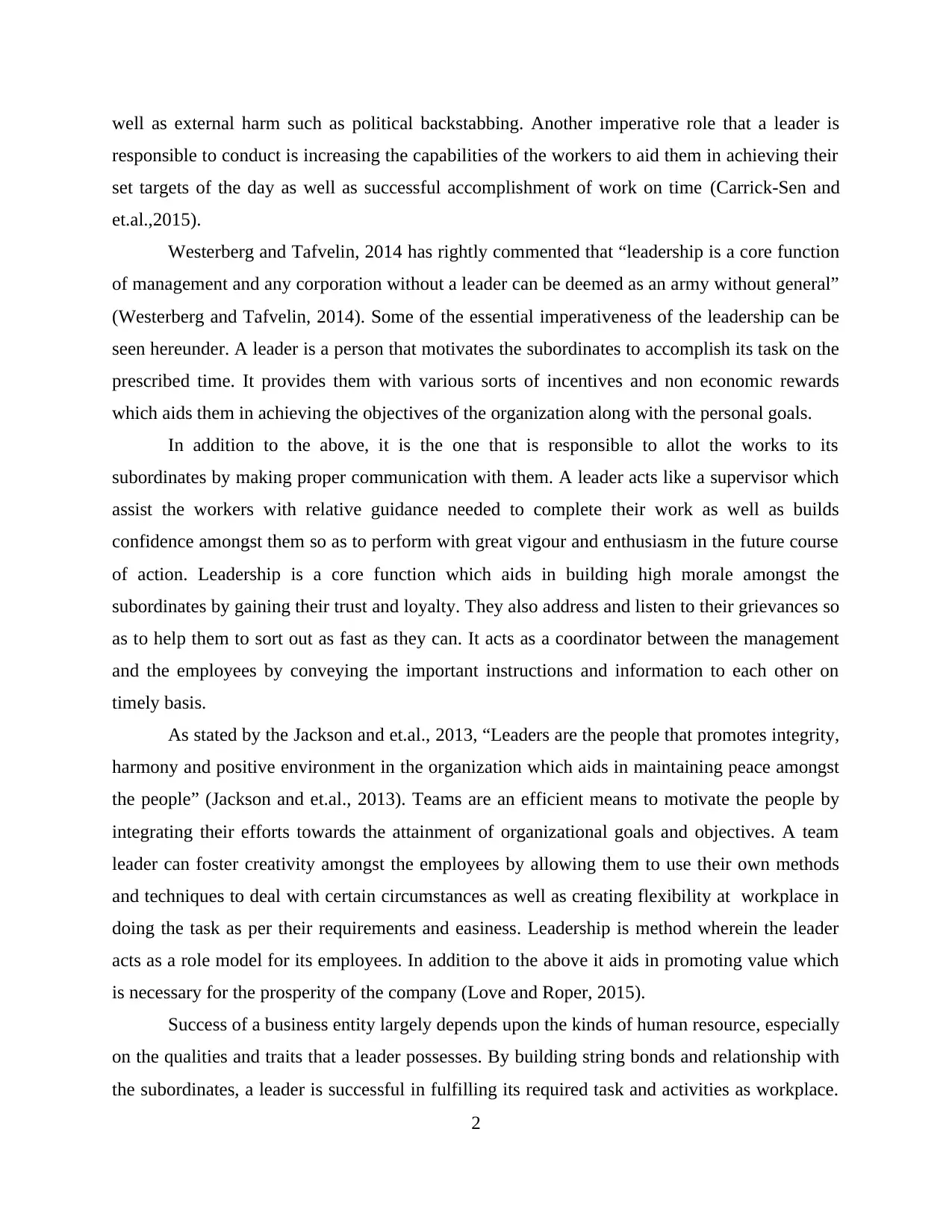
well as external harm such as political backstabbing. Another imperative role that a leader is
responsible to conduct is increasing the capabilities of the workers to aid them in achieving their
set targets of the day as well as successful accomplishment of work on time (Carrick-Sen and
et.al.,2015).
Westerberg and Tafvelin, 2014 has rightly commented that “leadership is a core function
of management and any corporation without a leader can be deemed as an army without general”
(Westerberg and Tafvelin, 2014). Some of the essential imperativeness of the leadership can be
seen hereunder. A leader is a person that motivates the subordinates to accomplish its task on the
prescribed time. It provides them with various sorts of incentives and non economic rewards
which aids them in achieving the objectives of the organization along with the personal goals.
In addition to the above, it is the one that is responsible to allot the works to its
subordinates by making proper communication with them. A leader acts like a supervisor which
assist the workers with relative guidance needed to complete their work as well as builds
confidence amongst them so as to perform with great vigour and enthusiasm in the future course
of action. Leadership is a core function which aids in building high morale amongst the
subordinates by gaining their trust and loyalty. They also address and listen to their grievances so
as to help them to sort out as fast as they can. It acts as a coordinator between the management
and the employees by conveying the important instructions and information to each other on
timely basis.
As stated by the Jackson and et.al., 2013, “Leaders are the people that promotes integrity,
harmony and positive environment in the organization which aids in maintaining peace amongst
the people” (Jackson and et.al., 2013). Teams are an efficient means to motivate the people by
integrating their efforts towards the attainment of organizational goals and objectives. A team
leader can foster creativity amongst the employees by allowing them to use their own methods
and techniques to deal with certain circumstances as well as creating flexibility at workplace in
doing the task as per their requirements and easiness. Leadership is method wherein the leader
acts as a role model for its employees. In addition to the above it aids in promoting value which
is necessary for the prosperity of the company (Love and Roper, 2015).
Success of a business entity largely depends upon the kinds of human resource, especially
on the qualities and traits that a leader possesses. By building string bonds and relationship with
the subordinates, a leader is successful in fulfilling its required task and activities as workplace.
2
responsible to conduct is increasing the capabilities of the workers to aid them in achieving their
set targets of the day as well as successful accomplishment of work on time (Carrick-Sen and
et.al.,2015).
Westerberg and Tafvelin, 2014 has rightly commented that “leadership is a core function
of management and any corporation without a leader can be deemed as an army without general”
(Westerberg and Tafvelin, 2014). Some of the essential imperativeness of the leadership can be
seen hereunder. A leader is a person that motivates the subordinates to accomplish its task on the
prescribed time. It provides them with various sorts of incentives and non economic rewards
which aids them in achieving the objectives of the organization along with the personal goals.
In addition to the above, it is the one that is responsible to allot the works to its
subordinates by making proper communication with them. A leader acts like a supervisor which
assist the workers with relative guidance needed to complete their work as well as builds
confidence amongst them so as to perform with great vigour and enthusiasm in the future course
of action. Leadership is a core function which aids in building high morale amongst the
subordinates by gaining their trust and loyalty. They also address and listen to their grievances so
as to help them to sort out as fast as they can. It acts as a coordinator between the management
and the employees by conveying the important instructions and information to each other on
timely basis.
As stated by the Jackson and et.al., 2013, “Leaders are the people that promotes integrity,
harmony and positive environment in the organization which aids in maintaining peace amongst
the people” (Jackson and et.al., 2013). Teams are an efficient means to motivate the people by
integrating their efforts towards the attainment of organizational goals and objectives. A team
leader can foster creativity amongst the employees by allowing them to use their own methods
and techniques to deal with certain circumstances as well as creating flexibility at workplace in
doing the task as per their requirements and easiness. Leadership is method wherein the leader
acts as a role model for its employees. In addition to the above it aids in promoting value which
is necessary for the prosperity of the company (Love and Roper, 2015).
Success of a business entity largely depends upon the kinds of human resource, especially
on the qualities and traits that a leader possesses. By building string bonds and relationship with
the subordinates, a leader is successful in fulfilling its required task and activities as workplace.
2
Secure Best Marks with AI Grader
Need help grading? Try our AI Grader for instant feedback on your assignments.
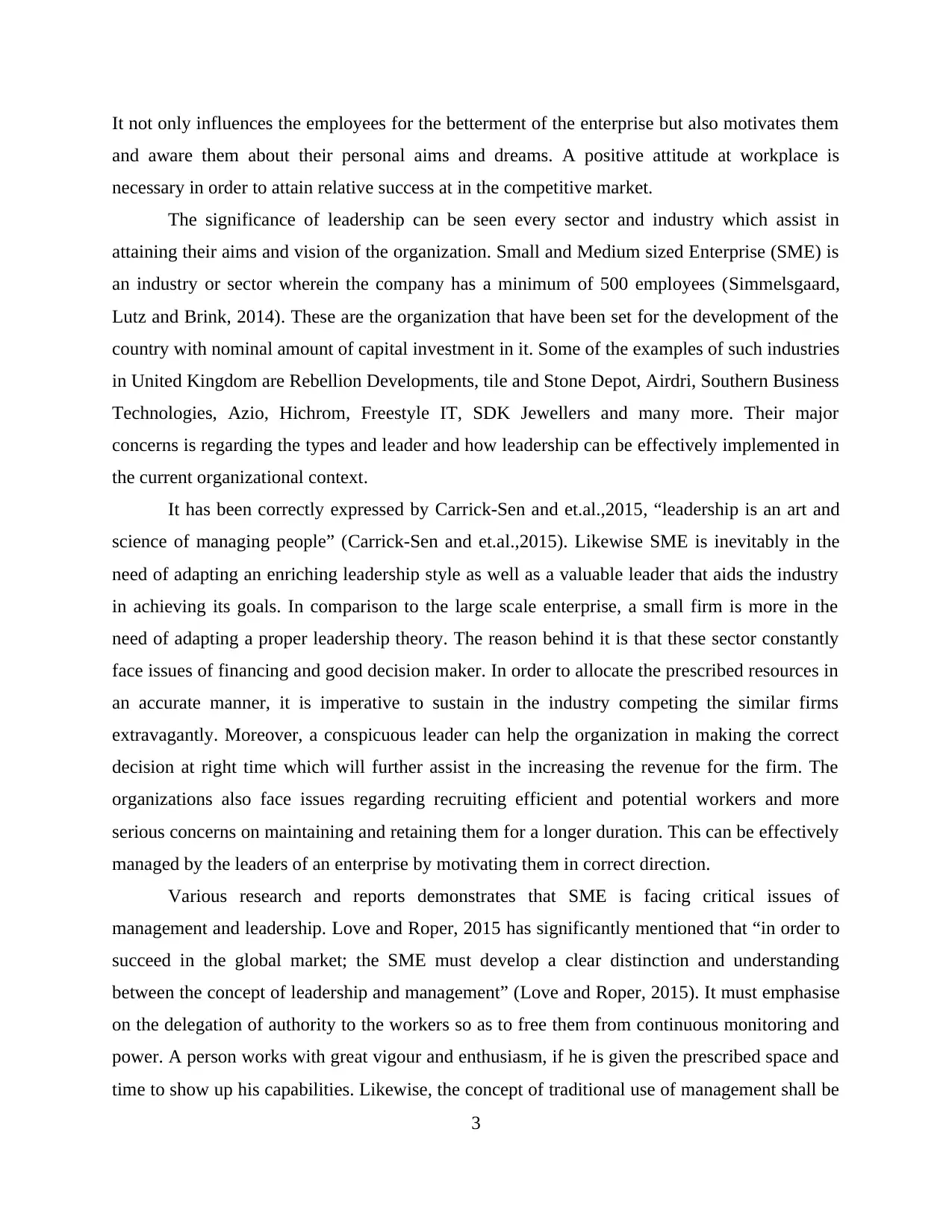
It not only influences the employees for the betterment of the enterprise but also motivates them
and aware them about their personal aims and dreams. A positive attitude at workplace is
necessary in order to attain relative success at in the competitive market.
The significance of leadership can be seen every sector and industry which assist in
attaining their aims and vision of the organization. Small and Medium sized Enterprise (SME) is
an industry or sector wherein the company has a minimum of 500 employees (Simmelsgaard,
Lutz and Brink, 2014). These are the organization that have been set for the development of the
country with nominal amount of capital investment in it. Some of the examples of such industries
in United Kingdom are Rebellion Developments, tile and Stone Depot, Airdri, Southern Business
Technologies, Azio, Hichrom, Freestyle IT, SDK Jewellers and many more. Their major
concerns is regarding the types and leader and how leadership can be effectively implemented in
the current organizational context.
It has been correctly expressed by Carrick-Sen and et.al.,2015, “leadership is an art and
science of managing people” (Carrick-Sen and et.al.,2015). Likewise SME is inevitably in the
need of adapting an enriching leadership style as well as a valuable leader that aids the industry
in achieving its goals. In comparison to the large scale enterprise, a small firm is more in the
need of adapting a proper leadership theory. The reason behind it is that these sector constantly
face issues of financing and good decision maker. In order to allocate the prescribed resources in
an accurate manner, it is imperative to sustain in the industry competing the similar firms
extravagantly. Moreover, a conspicuous leader can help the organization in making the correct
decision at right time which will further assist in the increasing the revenue for the firm. The
organizations also face issues regarding recruiting efficient and potential workers and more
serious concerns on maintaining and retaining them for a longer duration. This can be effectively
managed by the leaders of an enterprise by motivating them in correct direction.
Various research and reports demonstrates that SME is facing critical issues of
management and leadership. Love and Roper, 2015 has significantly mentioned that “in order to
succeed in the global market; the SME must develop a clear distinction and understanding
between the concept of leadership and management” (Love and Roper, 2015). It must emphasise
on the delegation of authority to the workers so as to free them from continuous monitoring and
power. A person works with great vigour and enthusiasm, if he is given the prescribed space and
time to show up his capabilities. Likewise, the concept of traditional use of management shall be
3
and aware them about their personal aims and dreams. A positive attitude at workplace is
necessary in order to attain relative success at in the competitive market.
The significance of leadership can be seen every sector and industry which assist in
attaining their aims and vision of the organization. Small and Medium sized Enterprise (SME) is
an industry or sector wherein the company has a minimum of 500 employees (Simmelsgaard,
Lutz and Brink, 2014). These are the organization that have been set for the development of the
country with nominal amount of capital investment in it. Some of the examples of such industries
in United Kingdom are Rebellion Developments, tile and Stone Depot, Airdri, Southern Business
Technologies, Azio, Hichrom, Freestyle IT, SDK Jewellers and many more. Their major
concerns is regarding the types and leader and how leadership can be effectively implemented in
the current organizational context.
It has been correctly expressed by Carrick-Sen and et.al.,2015, “leadership is an art and
science of managing people” (Carrick-Sen and et.al.,2015). Likewise SME is inevitably in the
need of adapting an enriching leadership style as well as a valuable leader that aids the industry
in achieving its goals. In comparison to the large scale enterprise, a small firm is more in the
need of adapting a proper leadership theory. The reason behind it is that these sector constantly
face issues of financing and good decision maker. In order to allocate the prescribed resources in
an accurate manner, it is imperative to sustain in the industry competing the similar firms
extravagantly. Moreover, a conspicuous leader can help the organization in making the correct
decision at right time which will further assist in the increasing the revenue for the firm. The
organizations also face issues regarding recruiting efficient and potential workers and more
serious concerns on maintaining and retaining them for a longer duration. This can be effectively
managed by the leaders of an enterprise by motivating them in correct direction.
Various research and reports demonstrates that SME is facing critical issues of
management and leadership. Love and Roper, 2015 has significantly mentioned that “in order to
succeed in the global market; the SME must develop a clear distinction and understanding
between the concept of leadership and management” (Love and Roper, 2015). It must emphasise
on the delegation of authority to the workers so as to free them from continuous monitoring and
power. A person works with great vigour and enthusiasm, if he is given the prescribed space and
time to show up his capabilities. Likewise, the concept of traditional use of management shall be
3
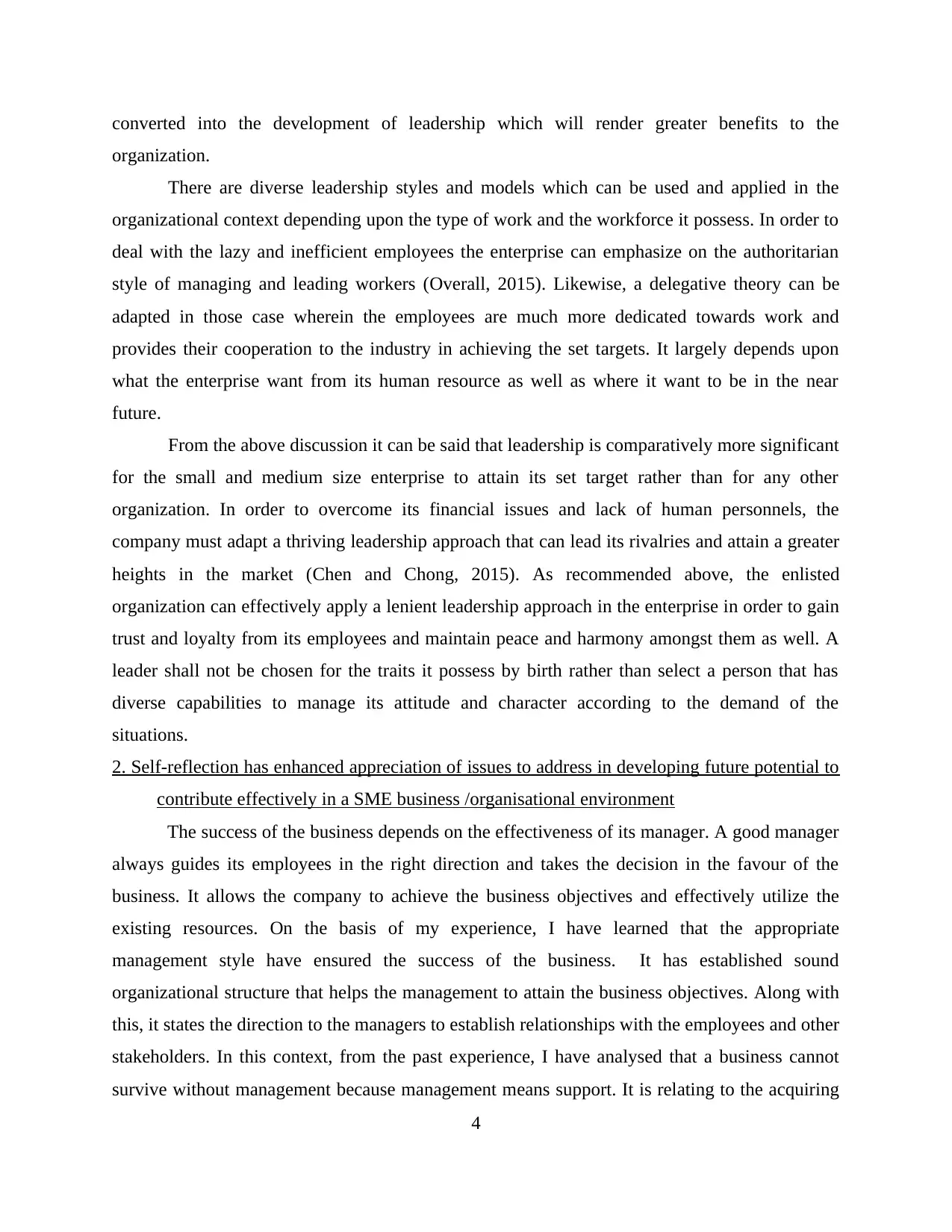
converted into the development of leadership which will render greater benefits to the
organization.
There are diverse leadership styles and models which can be used and applied in the
organizational context depending upon the type of work and the workforce it possess. In order to
deal with the lazy and inefficient employees the enterprise can emphasize on the authoritarian
style of managing and leading workers (Overall, 2015). Likewise, a delegative theory can be
adapted in those case wherein the employees are much more dedicated towards work and
provides their cooperation to the industry in achieving the set targets. It largely depends upon
what the enterprise want from its human resource as well as where it want to be in the near
future.
From the above discussion it can be said that leadership is comparatively more significant
for the small and medium size enterprise to attain its set target rather than for any other
organization. In order to overcome its financial issues and lack of human personnels, the
company must adapt a thriving leadership approach that can lead its rivalries and attain a greater
heights in the market (Chen and Chong, 2015). As recommended above, the enlisted
organization can effectively apply a lenient leadership approach in the enterprise in order to gain
trust and loyalty from its employees and maintain peace and harmony amongst them as well. A
leader shall not be chosen for the traits it possess by birth rather than select a person that has
diverse capabilities to manage its attitude and character according to the demand of the
situations.
2. Self-reflection has enhanced appreciation of issues to address in developing future potential to
contribute effectively in a SME business /organisational environment
The success of the business depends on the effectiveness of its manager. A good manager
always guides its employees in the right direction and takes the decision in the favour of the
business. It allows the company to achieve the business objectives and effectively utilize the
existing resources. On the basis of my experience, I have learned that the appropriate
management style have ensured the success of the business. It has established sound
organizational structure that helps the management to attain the business objectives. Along with
this, it states the direction to the managers to establish relationships with the employees and other
stakeholders. In this context, from the past experience, I have analysed that a business cannot
survive without management because management means support. It is relating to the acquiring
4
organization.
There are diverse leadership styles and models which can be used and applied in the
organizational context depending upon the type of work and the workforce it possess. In order to
deal with the lazy and inefficient employees the enterprise can emphasize on the authoritarian
style of managing and leading workers (Overall, 2015). Likewise, a delegative theory can be
adapted in those case wherein the employees are much more dedicated towards work and
provides their cooperation to the industry in achieving the set targets. It largely depends upon
what the enterprise want from its human resource as well as where it want to be in the near
future.
From the above discussion it can be said that leadership is comparatively more significant
for the small and medium size enterprise to attain its set target rather than for any other
organization. In order to overcome its financial issues and lack of human personnels, the
company must adapt a thriving leadership approach that can lead its rivalries and attain a greater
heights in the market (Chen and Chong, 2015). As recommended above, the enlisted
organization can effectively apply a lenient leadership approach in the enterprise in order to gain
trust and loyalty from its employees and maintain peace and harmony amongst them as well. A
leader shall not be chosen for the traits it possess by birth rather than select a person that has
diverse capabilities to manage its attitude and character according to the demand of the
situations.
2. Self-reflection has enhanced appreciation of issues to address in developing future potential to
contribute effectively in a SME business /organisational environment
The success of the business depends on the effectiveness of its manager. A good manager
always guides its employees in the right direction and takes the decision in the favour of the
business. It allows the company to achieve the business objectives and effectively utilize the
existing resources. On the basis of my experience, I have learned that the appropriate
management style have ensured the success of the business. It has established sound
organizational structure that helps the management to attain the business objectives. Along with
this, it states the direction to the managers to establish relationships with the employees and other
stakeholders. In this context, from the past experience, I have analysed that a business cannot
survive without management because management means support. It is relating to the acquiring
4
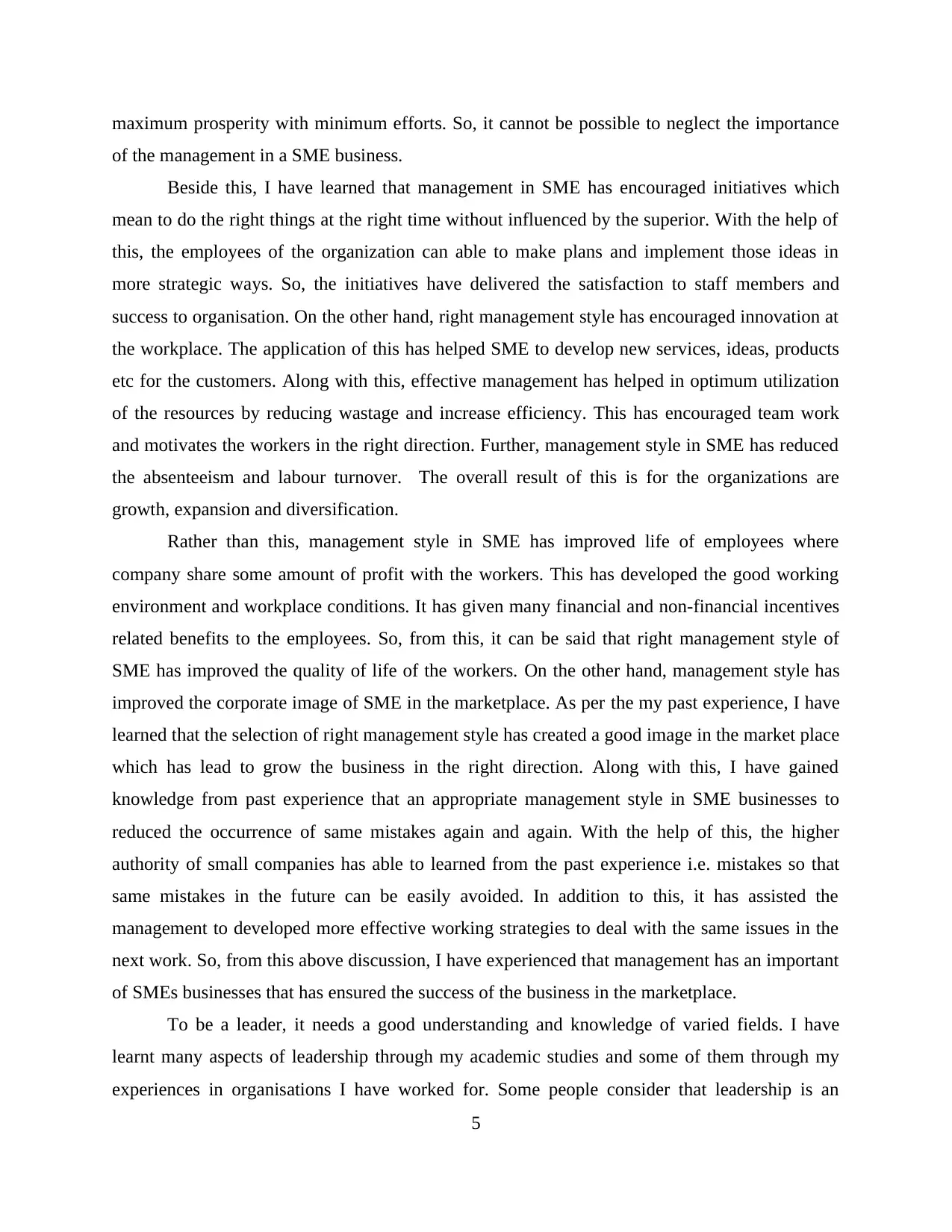
maximum prosperity with minimum efforts. So, it cannot be possible to neglect the importance
of the management in a SME business.
Beside this, I have learned that management in SME has encouraged initiatives which
mean to do the right things at the right time without influenced by the superior. With the help of
this, the employees of the organization can able to make plans and implement those ideas in
more strategic ways. So, the initiatives have delivered the satisfaction to staff members and
success to organisation. On the other hand, right management style has encouraged innovation at
the workplace. The application of this has helped SME to develop new services, ideas, products
etc for the customers. Along with this, effective management has helped in optimum utilization
of the resources by reducing wastage and increase efficiency. This has encouraged team work
and motivates the workers in the right direction. Further, management style in SME has reduced
the absenteeism and labour turnover. The overall result of this is for the organizations are
growth, expansion and diversification.
Rather than this, management style in SME has improved life of employees where
company share some amount of profit with the workers. This has developed the good working
environment and workplace conditions. It has given many financial and non-financial incentives
related benefits to the employees. So, from this, it can be said that right management style of
SME has improved the quality of life of the workers. On the other hand, management style has
improved the corporate image of SME in the marketplace. As per the my past experience, I have
learned that the selection of right management style has created a good image in the market place
which has lead to grow the business in the right direction. Along with this, I have gained
knowledge from past experience that an appropriate management style in SME businesses to
reduced the occurrence of same mistakes again and again. With the help of this, the higher
authority of small companies has able to learned from the past experience i.e. mistakes so that
same mistakes in the future can be easily avoided. In addition to this, it has assisted the
management to developed more effective working strategies to deal with the same issues in the
next work. So, from this above discussion, I have experienced that management has an important
of SMEs businesses that has ensured the success of the business in the marketplace.
To be a leader, it needs a good understanding and knowledge of varied fields. I have
learnt many aspects of leadership through my academic studies and some of them through my
experiences in organisations I have worked for. Some people consider that leadership is an
5
of the management in a SME business.
Beside this, I have learned that management in SME has encouraged initiatives which
mean to do the right things at the right time without influenced by the superior. With the help of
this, the employees of the organization can able to make plans and implement those ideas in
more strategic ways. So, the initiatives have delivered the satisfaction to staff members and
success to organisation. On the other hand, right management style has encouraged innovation at
the workplace. The application of this has helped SME to develop new services, ideas, products
etc for the customers. Along with this, effective management has helped in optimum utilization
of the resources by reducing wastage and increase efficiency. This has encouraged team work
and motivates the workers in the right direction. Further, management style in SME has reduced
the absenteeism and labour turnover. The overall result of this is for the organizations are
growth, expansion and diversification.
Rather than this, management style in SME has improved life of employees where
company share some amount of profit with the workers. This has developed the good working
environment and workplace conditions. It has given many financial and non-financial incentives
related benefits to the employees. So, from this, it can be said that right management style of
SME has improved the quality of life of the workers. On the other hand, management style has
improved the corporate image of SME in the marketplace. As per the my past experience, I have
learned that the selection of right management style has created a good image in the market place
which has lead to grow the business in the right direction. Along with this, I have gained
knowledge from past experience that an appropriate management style in SME businesses to
reduced the occurrence of same mistakes again and again. With the help of this, the higher
authority of small companies has able to learned from the past experience i.e. mistakes so that
same mistakes in the future can be easily avoided. In addition to this, it has assisted the
management to developed more effective working strategies to deal with the same issues in the
next work. So, from this above discussion, I have experienced that management has an important
of SMEs businesses that has ensured the success of the business in the marketplace.
To be a leader, it needs a good understanding and knowledge of varied fields. I have
learnt many aspects of leadership through my academic studies and some of them through my
experiences in organisations I have worked for. Some people consider that leadership is an
5
Paraphrase This Document
Need a fresh take? Get an instant paraphrase of this document with our AI Paraphraser
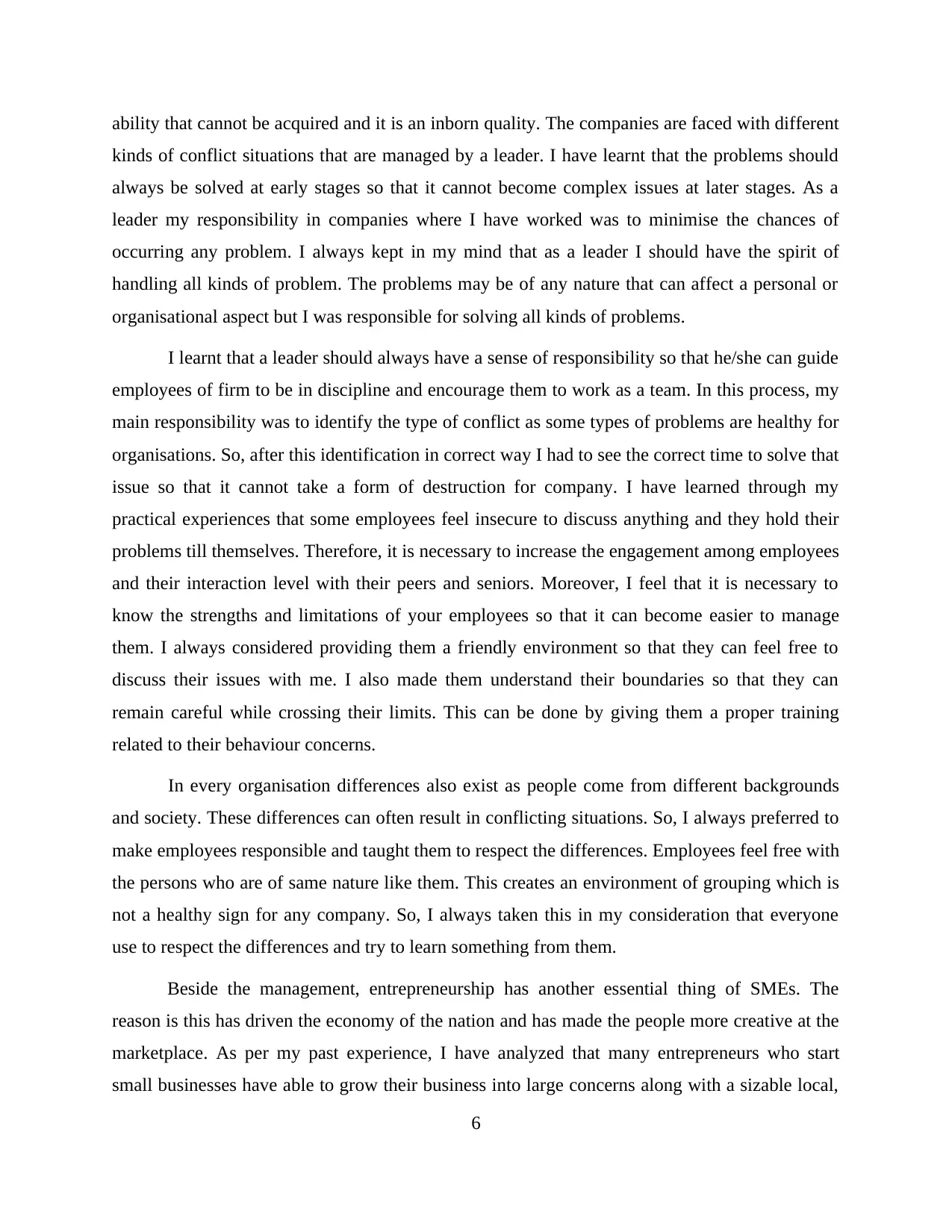
ability that cannot be acquired and it is an inborn quality. The companies are faced with different
kinds of conflict situations that are managed by a leader. I have learnt that the problems should
always be solved at early stages so that it cannot become complex issues at later stages. As a
leader my responsibility in companies where I have worked was to minimise the chances of
occurring any problem. I always kept in my mind that as a leader I should have the spirit of
handling all kinds of problem. The problems may be of any nature that can affect a personal or
organisational aspect but I was responsible for solving all kinds of problems.
I learnt that a leader should always have a sense of responsibility so that he/she can guide
employees of firm to be in discipline and encourage them to work as a team. In this process, my
main responsibility was to identify the type of conflict as some types of problems are healthy for
organisations. So, after this identification in correct way I had to see the correct time to solve that
issue so that it cannot take a form of destruction for company. I have learned through my
practical experiences that some employees feel insecure to discuss anything and they hold their
problems till themselves. Therefore, it is necessary to increase the engagement among employees
and their interaction level with their peers and seniors. Moreover, I feel that it is necessary to
know the strengths and limitations of your employees so that it can become easier to manage
them. I always considered providing them a friendly environment so that they can feel free to
discuss their issues with me. I also made them understand their boundaries so that they can
remain careful while crossing their limits. This can be done by giving them a proper training
related to their behaviour concerns.
In every organisation differences also exist as people come from different backgrounds
and society. These differences can often result in conflicting situations. So, I always preferred to
make employees responsible and taught them to respect the differences. Employees feel free with
the persons who are of same nature like them. This creates an environment of grouping which is
not a healthy sign for any company. So, I always taken this in my consideration that everyone
use to respect the differences and try to learn something from them.
Beside the management, entrepreneurship has another essential thing of SMEs. The
reason is this has driven the economy of the nation and has made the people more creative at the
marketplace. As per my past experience, I have analyzed that many entrepreneurs who start
small businesses have able to grow their business into large concerns along with a sizable local,
6
kinds of conflict situations that are managed by a leader. I have learnt that the problems should
always be solved at early stages so that it cannot become complex issues at later stages. As a
leader my responsibility in companies where I have worked was to minimise the chances of
occurring any problem. I always kept in my mind that as a leader I should have the spirit of
handling all kinds of problem. The problems may be of any nature that can affect a personal or
organisational aspect but I was responsible for solving all kinds of problems.
I learnt that a leader should always have a sense of responsibility so that he/she can guide
employees of firm to be in discipline and encourage them to work as a team. In this process, my
main responsibility was to identify the type of conflict as some types of problems are healthy for
organisations. So, after this identification in correct way I had to see the correct time to solve that
issue so that it cannot take a form of destruction for company. I have learned through my
practical experiences that some employees feel insecure to discuss anything and they hold their
problems till themselves. Therefore, it is necessary to increase the engagement among employees
and their interaction level with their peers and seniors. Moreover, I feel that it is necessary to
know the strengths and limitations of your employees so that it can become easier to manage
them. I always considered providing them a friendly environment so that they can feel free to
discuss their issues with me. I also made them understand their boundaries so that they can
remain careful while crossing their limits. This can be done by giving them a proper training
related to their behaviour concerns.
In every organisation differences also exist as people come from different backgrounds
and society. These differences can often result in conflicting situations. So, I always preferred to
make employees responsible and taught them to respect the differences. Employees feel free with
the persons who are of same nature like them. This creates an environment of grouping which is
not a healthy sign for any company. So, I always taken this in my consideration that everyone
use to respect the differences and try to learn something from them.
Beside the management, entrepreneurship has another essential thing of SMEs. The
reason is this has driven the economy of the nation and has made the people more creative at the
marketplace. As per my past experience, I have analyzed that many entrepreneurs who start
small businesses have able to grow their business into large concerns along with a sizable local,
6
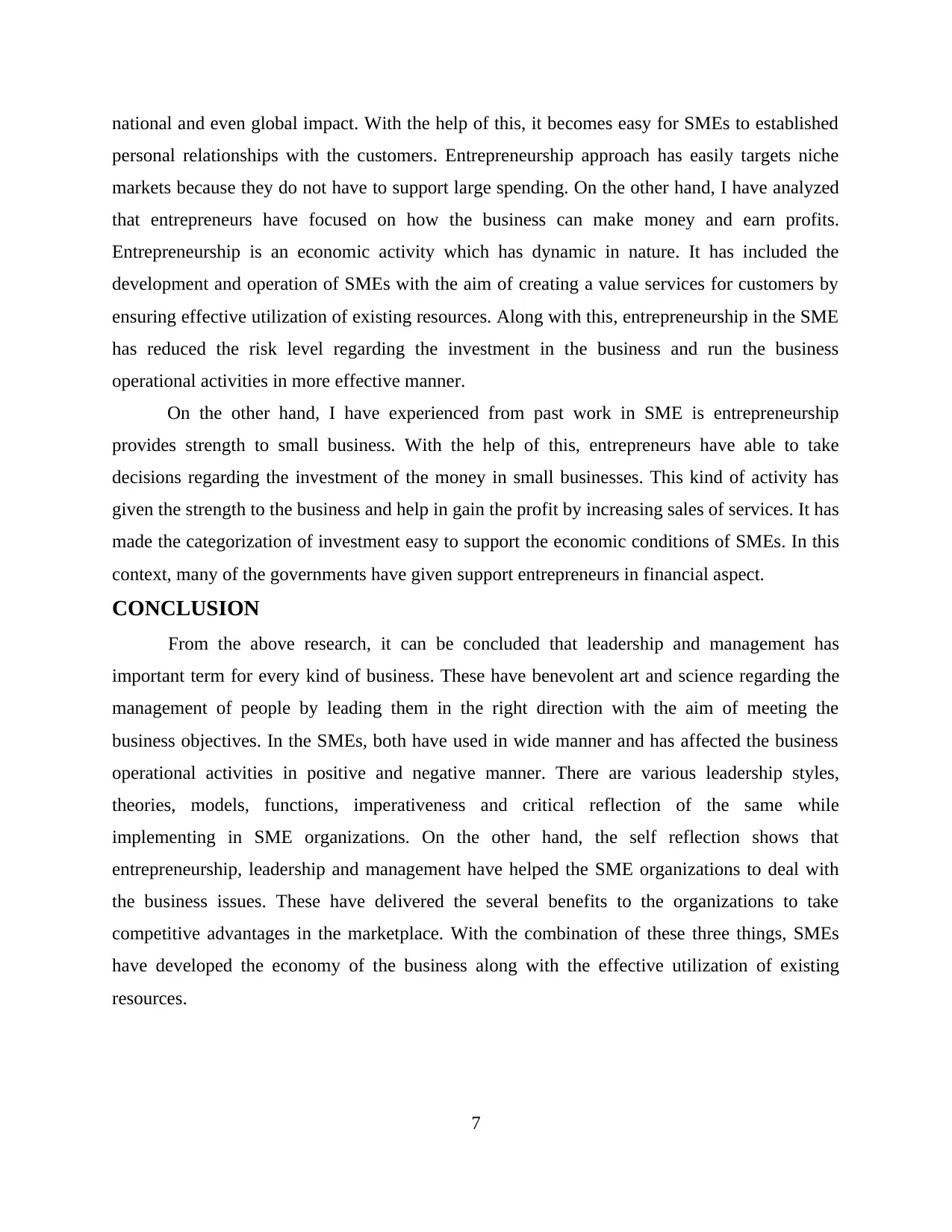
national and even global impact. With the help of this, it becomes easy for SMEs to established
personal relationships with the customers. Entrepreneurship approach has easily targets niche
markets because they do not have to support large spending. On the other hand, I have analyzed
that entrepreneurs have focused on how the business can make money and earn profits.
Entrepreneurship is an economic activity which has dynamic in nature. It has included the
development and operation of SMEs with the aim of creating a value services for customers by
ensuring effective utilization of existing resources. Along with this, entrepreneurship in the SME
has reduced the risk level regarding the investment in the business and run the business
operational activities in more effective manner.
On the other hand, I have experienced from past work in SME is entrepreneurship
provides strength to small business. With the help of this, entrepreneurs have able to take
decisions regarding the investment of the money in small businesses. This kind of activity has
given the strength to the business and help in gain the profit by increasing sales of services. It has
made the categorization of investment easy to support the economic conditions of SMEs. In this
context, many of the governments have given support entrepreneurs in financial aspect.
CONCLUSION
From the above research, it can be concluded that leadership and management has
important term for every kind of business. These have benevolent art and science regarding the
management of people by leading them in the right direction with the aim of meeting the
business objectives. In the SMEs, both have used in wide manner and has affected the business
operational activities in positive and negative manner. There are various leadership styles,
theories, models, functions, imperativeness and critical reflection of the same while
implementing in SME organizations. On the other hand, the self reflection shows that
entrepreneurship, leadership and management have helped the SME organizations to deal with
the business issues. These have delivered the several benefits to the organizations to take
competitive advantages in the marketplace. With the combination of these three things, SMEs
have developed the economy of the business along with the effective utilization of existing
resources.
7
personal relationships with the customers. Entrepreneurship approach has easily targets niche
markets because they do not have to support large spending. On the other hand, I have analyzed
that entrepreneurs have focused on how the business can make money and earn profits.
Entrepreneurship is an economic activity which has dynamic in nature. It has included the
development and operation of SMEs with the aim of creating a value services for customers by
ensuring effective utilization of existing resources. Along with this, entrepreneurship in the SME
has reduced the risk level regarding the investment in the business and run the business
operational activities in more effective manner.
On the other hand, I have experienced from past work in SME is entrepreneurship
provides strength to small business. With the help of this, entrepreneurs have able to take
decisions regarding the investment of the money in small businesses. This kind of activity has
given the strength to the business and help in gain the profit by increasing sales of services. It has
made the categorization of investment easy to support the economic conditions of SMEs. In this
context, many of the governments have given support entrepreneurs in financial aspect.
CONCLUSION
From the above research, it can be concluded that leadership and management has
important term for every kind of business. These have benevolent art and science regarding the
management of people by leading them in the right direction with the aim of meeting the
business objectives. In the SMEs, both have used in wide manner and has affected the business
operational activities in positive and negative manner. There are various leadership styles,
theories, models, functions, imperativeness and critical reflection of the same while
implementing in SME organizations. On the other hand, the self reflection shows that
entrepreneurship, leadership and management have helped the SME organizations to deal with
the business issues. These have delivered the several benefits to the organizations to take
competitive advantages in the marketplace. With the combination of these three things, SMEs
have developed the economy of the business along with the effective utilization of existing
resources.
7
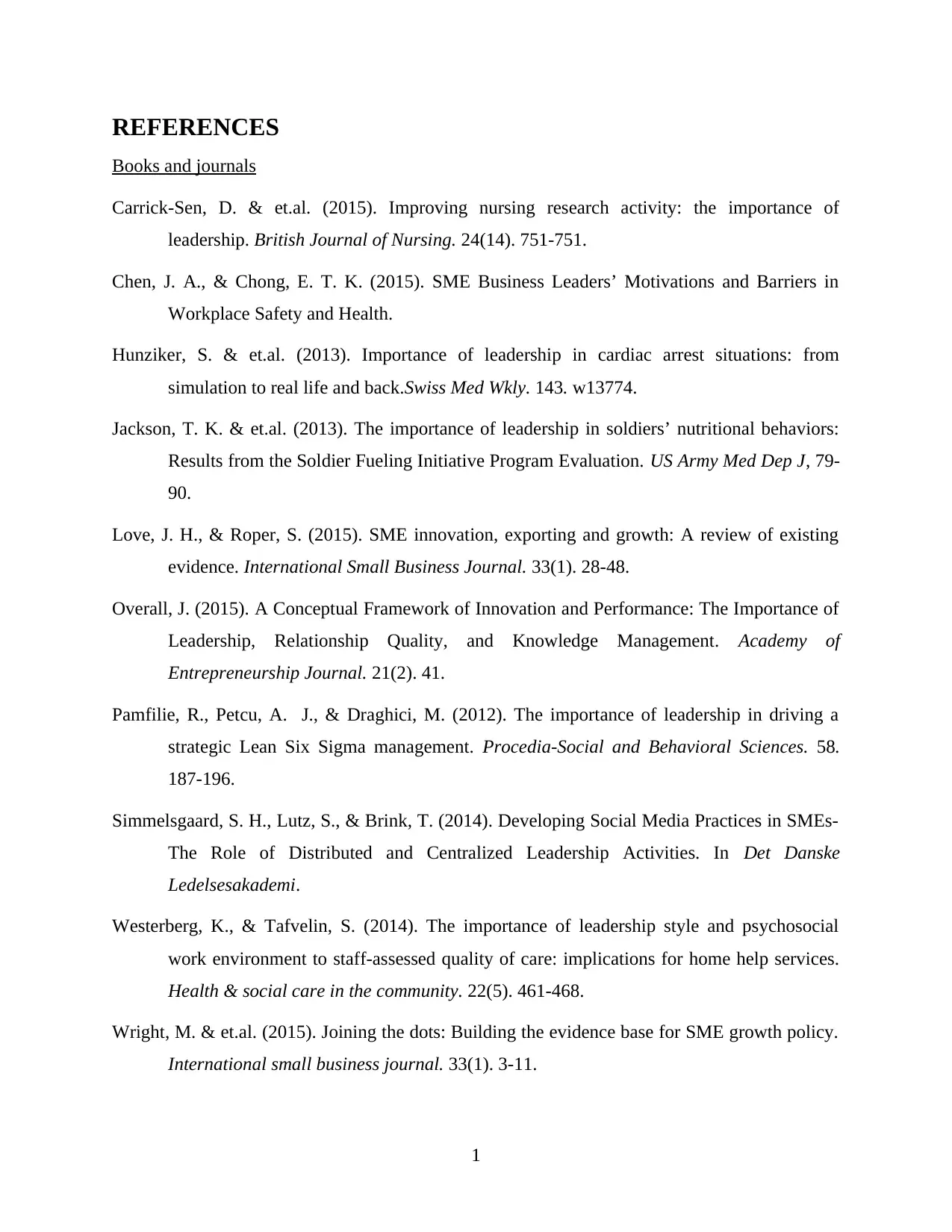
REFERENCES
Books and journals
Carrick-Sen, D. & et.al. (2015). Improving nursing research activity: the importance of
leadership. British Journal of Nursing. 24(14). 751-751.
Chen, J. A., & Chong, E. T. K. (2015). SME Business Leaders’ Motivations and Barriers in
Workplace Safety and Health.
Hunziker, S. & et.al. (2013). Importance of leadership in cardiac arrest situations: from
simulation to real life and back.Swiss Med Wkly. 143. w13774.
Jackson, T. K. & et.al. (2013). The importance of leadership in soldiers’ nutritional behaviors:
Results from the Soldier Fueling Initiative Program Evaluation. US Army Med Dep J, 79-
90.
Love, J. H., & Roper, S. (2015). SME innovation, exporting and growth: A review of existing
evidence. International Small Business Journal. 33(1). 28-48.
Overall, J. (2015). A Conceptual Framework of Innovation and Performance: The Importance of
Leadership, Relationship Quality, and Knowledge Management. Academy of
Entrepreneurship Journal. 21(2). 41.
Pamfilie, R., Petcu, A. J., & Draghici, M. (2012). The importance of leadership in driving a
strategic Lean Six Sigma management. Procedia-Social and Behavioral Sciences. 58.
187-196.
Simmelsgaard, S. H., Lutz, S., & Brink, T. (2014). Developing Social Media Practices in SMEs-
The Role of Distributed and Centralized Leadership Activities. In Det Danske
Ledelsesakademi.
Westerberg, K., & Tafvelin, S. (2014). The importance of leadership style and psychosocial
work environment to staff‐assessed quality of care: implications for home help services.
Health & social care in the community. 22(5). 461-468.
Wright, M. & et.al. (2015). Joining the dots: Building the evidence base for SME growth policy.
International small business journal. 33(1). 3-11.
1
Books and journals
Carrick-Sen, D. & et.al. (2015). Improving nursing research activity: the importance of
leadership. British Journal of Nursing. 24(14). 751-751.
Chen, J. A., & Chong, E. T. K. (2015). SME Business Leaders’ Motivations and Barriers in
Workplace Safety and Health.
Hunziker, S. & et.al. (2013). Importance of leadership in cardiac arrest situations: from
simulation to real life and back.Swiss Med Wkly. 143. w13774.
Jackson, T. K. & et.al. (2013). The importance of leadership in soldiers’ nutritional behaviors:
Results from the Soldier Fueling Initiative Program Evaluation. US Army Med Dep J, 79-
90.
Love, J. H., & Roper, S. (2015). SME innovation, exporting and growth: A review of existing
evidence. International Small Business Journal. 33(1). 28-48.
Overall, J. (2015). A Conceptual Framework of Innovation and Performance: The Importance of
Leadership, Relationship Quality, and Knowledge Management. Academy of
Entrepreneurship Journal. 21(2). 41.
Pamfilie, R., Petcu, A. J., & Draghici, M. (2012). The importance of leadership in driving a
strategic Lean Six Sigma management. Procedia-Social and Behavioral Sciences. 58.
187-196.
Simmelsgaard, S. H., Lutz, S., & Brink, T. (2014). Developing Social Media Practices in SMEs-
The Role of Distributed and Centralized Leadership Activities. In Det Danske
Ledelsesakademi.
Westerberg, K., & Tafvelin, S. (2014). The importance of leadership style and psychosocial
work environment to staff‐assessed quality of care: implications for home help services.
Health & social care in the community. 22(5). 461-468.
Wright, M. & et.al. (2015). Joining the dots: Building the evidence base for SME growth policy.
International small business journal. 33(1). 3-11.
1
1 out of 10
Your All-in-One AI-Powered Toolkit for Academic Success.
+13062052269
info@desklib.com
Available 24*7 on WhatsApp / Email
![[object Object]](/_next/static/media/star-bottom.7253800d.svg)
Unlock your academic potential
© 2024 | Zucol Services PVT LTD | All rights reserved.





